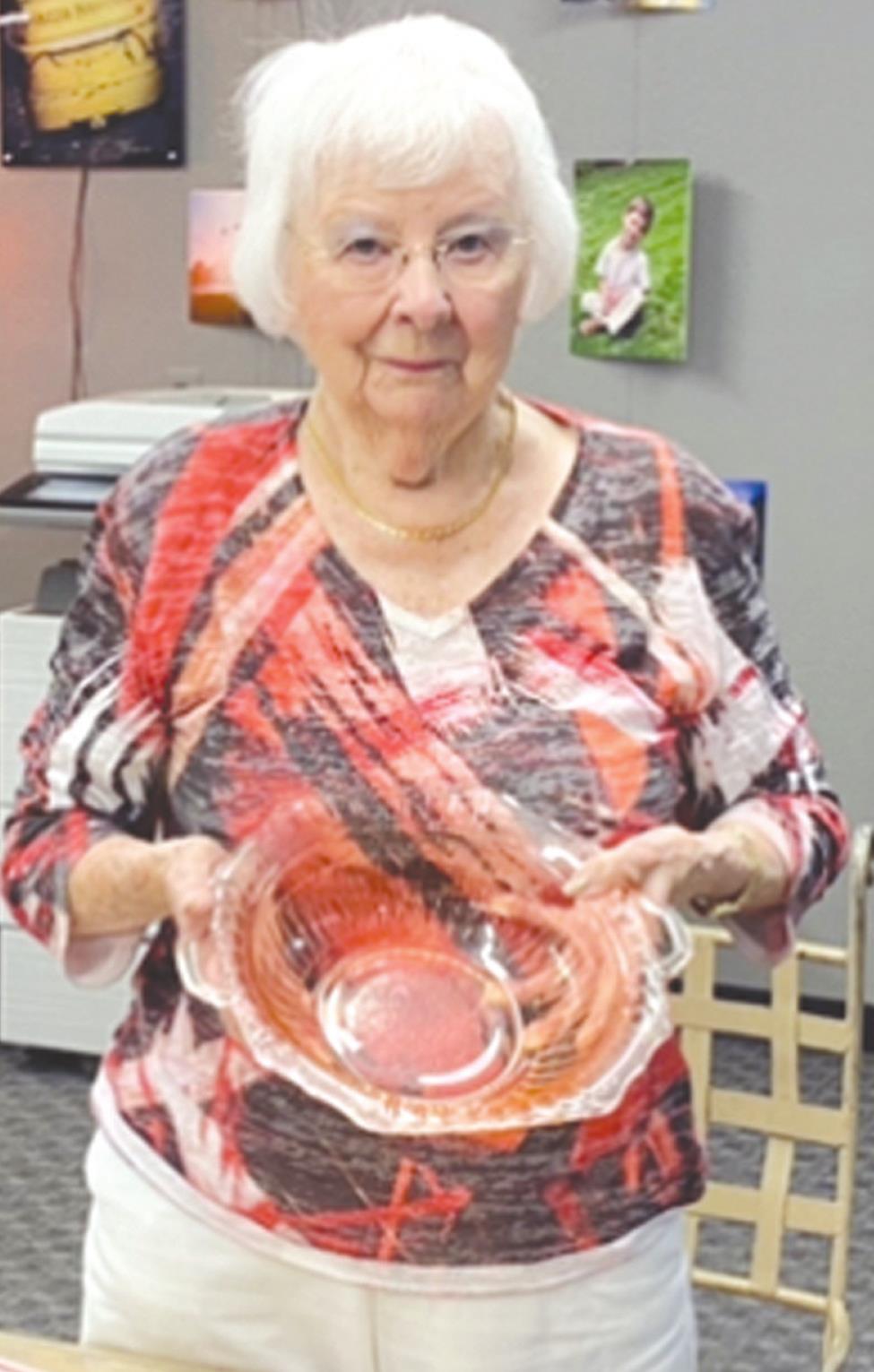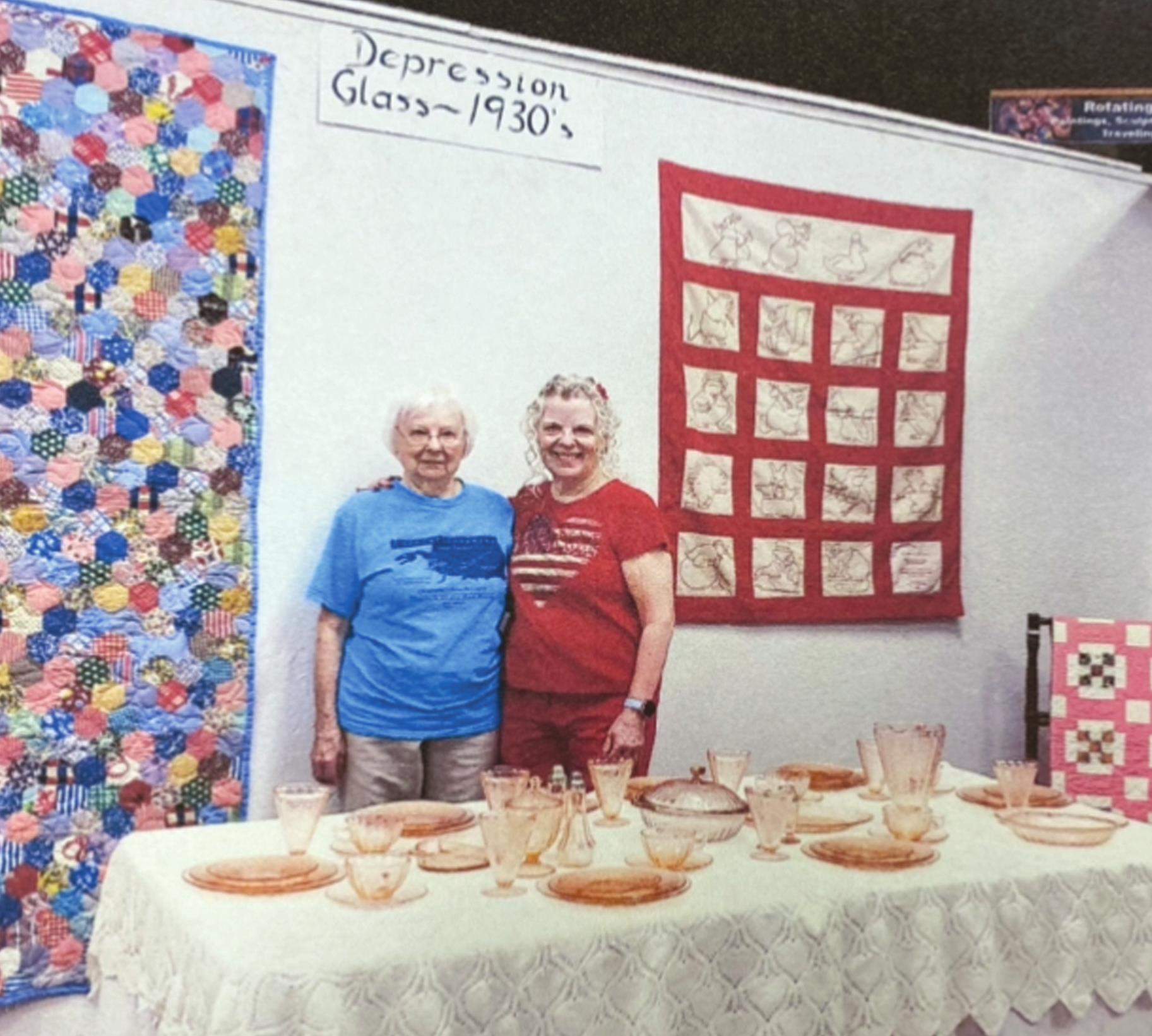Evelyn Hart is 94 years old and she and her husband have been collecting Depression glass and Depression glass pieces, which were made in the 1930s.
“One summer, my sister-in-law was visiting from Louisiana,” Hart said. “When she was visiting, she told us about Depression glass.”
Hart found a piece in her attic which she had for years. After she found the piece in her attic, she soon discovered there were shops and stores in towns in and near Custer County which sold the glass. “Depression glass was given in
“Depression glass was given in oatmeal boxes and similar products and was in different colors,” Hart said. “It would entice people to buy their products.”
Hart said the Depression glass can and still is used after all of these years.
“It was a collection which I enjoy looking at,” Hart said. “It means a lot to me that all of these Depression glass dishes I collected have lasted all of these years and can still be used.”
Hart has given some of her Depression glass to people who need it, such as one of her daughter’s hairdresser’s.
“I had another set and I sold it to my daughter Dari’s hairdresser,” Hart said. “I just have had them in the cabinets all these years and have not used them. I really enjoy how beautiful they look and her hairdresser uses the Depression glass all the time. His mother was coming to see him and he did not have any dishes, so this is why he brought them.”
Along with collecting Depression glass, Hart has other hobbies such as quilting, genealogy and collecting straw baskets.
“My husband and I collected home-made straw baskets made in Arkansas by individuals,” Hart said. “In 1988 and 1989, we traveled up SH 59 in Arkansas from Fort Smith, Arkansas, to Siloam Springs, Arkansas. At various places, there would be houses where they were making baskets. Some of our baskets are signed by John Hampton, of Pelsor Arkansas in 1988, Jerry and Pat Wood, of Pelsor, Arkansas, 1989.”
Hart and her husband Darrall got married in 1946 and were married for 51 years before Darrall passed away in 1997. Hart has two daughters, Marsha Ridenour and Dari Hart. Ridenhour lives in Yukon and Dari lives in Arlington, Texas. She also has two granddaughters, Lori Harvey and Lisa Harrington and has countless great grandchildren. Hart said her family motivates her and that is what keeps her going.
“I really enjoy spending time with my family,” Hart said. “I get to see my daughters and granddaughters often, which really is amazing.”
Darrall worked at Custer County Savings and Loan in Clinton and after he got off work, they would go to Bessie, Rocky, Gotebo and other towns buying Depression glass. They eventually settled on a set of Pink Floral Poinsettia, which was her favorite Depression glass she has collected and it currently is at the Heartland of America Museum. Hart said she also had a set of Yellow Lorain at one time.
Hart’s maiden name is Nowka and it is Wendish. The Wends, also called Sorbs, are a Slavic people who settled during the migrations of tribes after the collapse of the Roman Empire.
“They settled in central Europe in an area called Lusatia on the banks of the Spree River near the modern cities of Bautzen and Cottbus,” Hart said. “I know my grandfather on my father’s side had come from Cottbus, Germany.”
Wends suffered both economic and social discrimination as a result of Germans conquered the inhabitants of Lusatia. Wends were denied admission into professional and Wends in cities lived in specific sections. There were hard times which affected the Wends and Germans such as droughts and crop failures which brought hunger and poverty and the Wends eventually migrated to Texas in 1849.
“Even though the religious issue is at the heart of the 1854 migration to the United States, other considerations played a part in the decision to leave Germany,” Hart said. “My father said boys had to go to the service and great grandpa did not want his sons to leave home.”
A few Wends joined the 19th Century migration of Germans to the United States. These few Wends in turn influenced the decision of nearly 600 Wends from 65 villages and towns in Prussia and Saxony to join them. Embarking from Hamburg, Germany, in 1854, they traveled to Liverpool where they boarded a sailing ship called the Ben Nevis.
Although a number of people passed away during the 3-month journey, there were marriages and births enroute. They arrived at Galveston, Texas, December 16, 1854, and were eager to build homes in Texas and preserve their faith and traditions. In South Texas, a large group settled around Giddings and Serbin in Lee County, which is southeast of Austin, Texas.
The migration progressed and in 1869, Robert Hendreschke, Fred Kockrow and John Koinzan traveled to Clay County, Nebraska. Two families, Augustus Hoppens and Gottfried Nowka lived in Michigan a short time before they moved west. Two bachelor Wends, Martin Nesow and Christian Nowka traveled back to Europe in 1898 and returned with Wend wives. Hart’s Great Grandfather became a U.S. citizen in 1875.
In 1942 during World War II, an extensive area east of Hastings was taken by the U.S., for a U.S. Navy ammunition depot and the land of the congregation also were included. The cemetery of South Island, as it was called remained, but the church building and parsonage were moved to the Clay Center. The cemetery continues to exist for Zion burials and the tombstone of Christian Lobeda identifies Cottbus as his place of birth.
Gottfried Nowka and brother Johann came to America in 1873 on a ship called Deutschland departing from Breman, Germany, arriving on the east coast of the U.S.
A card game Schafkope (sheepshead) originated among the Wends who settled in the Erzebirge, in the mountains of Bohemia and Saxony. It was the inspiration for SKAT early in the 19th century.
A book “Is Search of a Home” by George R. Nielson is written about the Wendish immigration. It mainly talks about the Wends in Australia and Texas.



